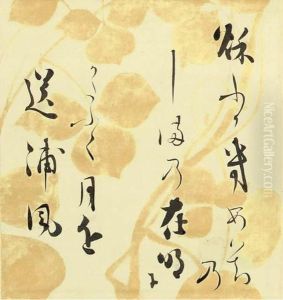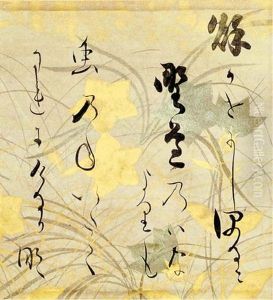Hon'Ami Koetsu Paintings
Hon'Ami Koetsu was a multifaceted Japanese artist renowned for his work in calligraphy, lacquerware, and pottery, and as an entrepreneur who played a significant role in the cultural world of Kyoto during the early Edo period. Born into a family of swordsmiths who were also known for their connoisseurship and appraisal of swords, Koetsu benefitted from an environment that valued artistic pursuits and craftsmanship.
His talents in calligraphy were first influenced by the flowing styles of the Heian period, and subsequently by the more disciplined approaches of the Zen monks. However, Koetsu's calligraphy is distinguished by its distinct character, which combined boldness with elegance. He was also admired for his waka poetry, a type of Japanese poetry which he often incorporated into his calligraphic works.
In addition to calligraphy, Koetsu was skilled in ceramics, creating tea bowls and other objects that are highly valued for their rustic beauty and the sense of naturalism they evoke. His style in ceramics was part of the Raku ware tradition, which was favored in the Japanese tea ceremony for its simplicity and understated elegance. Koetsu's contributions to this tradition helped to cement its place in Japanese cultural history.
Koetsu's expertise extended to lacquerware as well, where he collaborated with his brother-in-law, the lacquer artist Tawaraya Sotatsu. Together, they developed a style characterized by the use of gold and silver foil under clear lacquer, creating a shimmering effect that became a hallmark of the Rimpa school of painting and decorative arts. This collaboration contributed significantly to the aesthetics of the Edo period and left a lasting impact on Japanese art.
His legacy is also tied to the establishment of an artists' colony in northern Kyoto, known as the Takagamine, which he founded with the help of a wealthy merchant. This community attracted many artists and craftsmen, becoming a hub for creative activity and innovation.
Koetsu's influence on Japanese art history is profound, as he was instrumental in the development of several art forms and left behind works that are still celebrated today for their beauty and craftsmanship. His death in 1637 marked the end of a life that had a broad and lasting impact on the arts in Japan.

